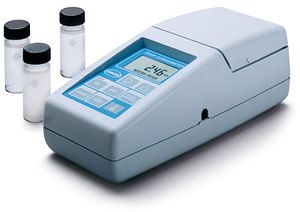Difference between revisions of "Turbidity Meters"
(Created page with "Category:Meters, Gauges{{Knoppen}} <noinclude><!------------------------------------------------ * READ THIS FIRST * Only edit this page if you can improve the content. ...") |
|||
| Line 7: | Line 7: | ||
* Please start editing this page after the /noinclude | * Please start editing this page after the /noinclude | ||
* -------------------------------------------------></noinclude> | * -------------------------------------------------></noinclude> | ||
[[File:Turbidity Meters.jpeg|thumb|right|Turbidity Meters]] | |||
'''Turbidity Meter''' is used to measure turbidity in the laboratory , in outdoor and field applications a portable turbidity meter would be used and for plant and process applications a continuous online controller would be used. Turbidity meters use an instrument called a nephelometer with the detector setup to the side of the light beam. More light reaches the detector if there are many small particles reflecting the source beam than if there are few. The units of turbidity from a calibrated nephelometer are called Nephelometric Turbidity Units (NTU). | |||
Turbidity is a measure of the cloudiness of water- the cloudier the water, the greater the turbidity. Turbidity is caused by suspended solids caused by phytoplankton, human activities that disturb land such as construction that can result in high sentiment levels. | |||
Turbidity is important because high turbidity in drinking water can lead to develop into gastrointestinal diseases. High turbidity in water bodies such as lakes, rivers and reservoirs, can reduce the amount of light reaching lower depths, which can inhibit growth of submerged aquatic plants and consequently affect species which are dependent on them, such as fish and shellfish. | |||
Latest revision as of 01:04, 26 December 2012
Turbidity Meter is used to measure turbidity in the laboratory , in outdoor and field applications a portable turbidity meter would be used and for plant and process applications a continuous online controller would be used. Turbidity meters use an instrument called a nephelometer with the detector setup to the side of the light beam. More light reaches the detector if there are many small particles reflecting the source beam than if there are few. The units of turbidity from a calibrated nephelometer are called Nephelometric Turbidity Units (NTU).
Turbidity is a measure of the cloudiness of water- the cloudier the water, the greater the turbidity. Turbidity is caused by suspended solids caused by phytoplankton, human activities that disturb land such as construction that can result in high sentiment levels.
Turbidity is important because high turbidity in drinking water can lead to develop into gastrointestinal diseases. High turbidity in water bodies such as lakes, rivers and reservoirs, can reduce the amount of light reaching lower depths, which can inhibit growth of submerged aquatic plants and consequently affect species which are dependent on them, such as fish and shellfish.
